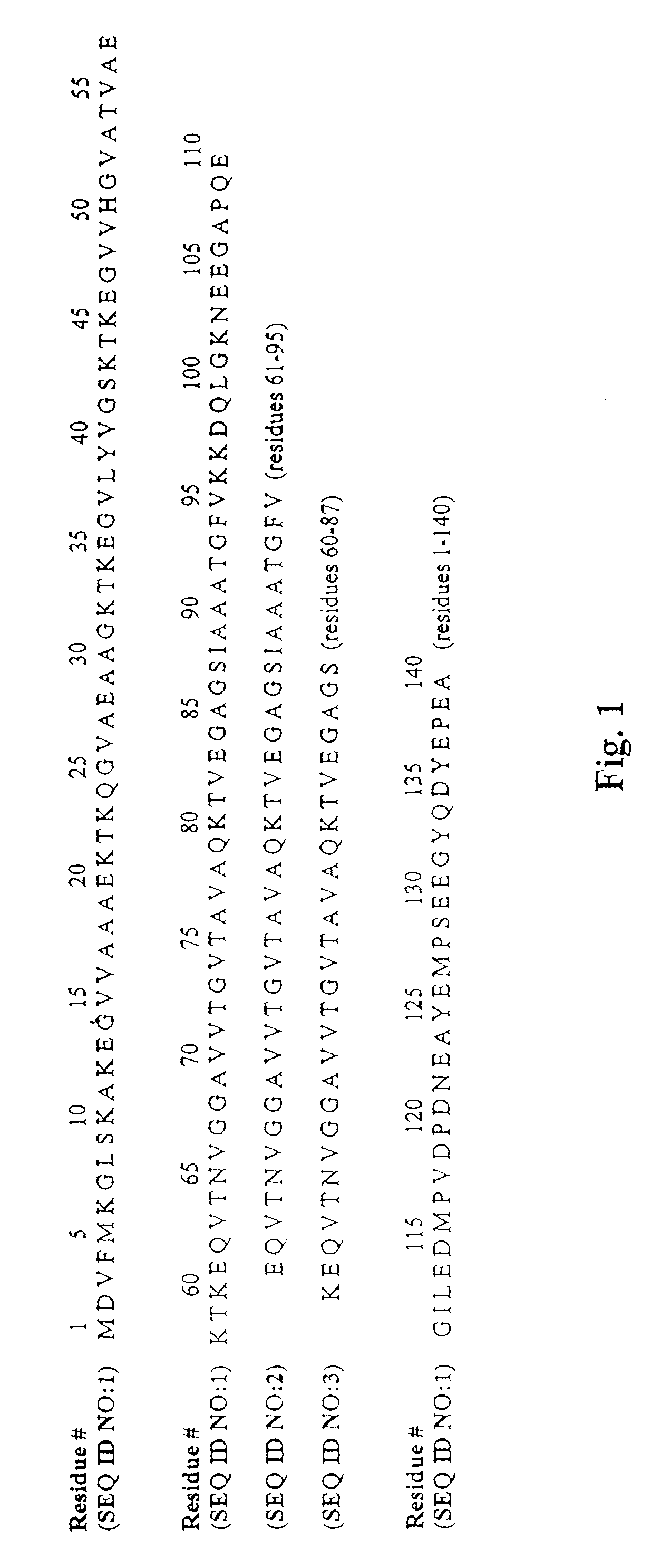Prevention And Treatment of Synucleinopathic And Amyloidogenic Disease
a technology of amyloid and amyloid, which is applied in the field of prevention and treatment of synucleinopathic and amyloidogenic disease, can solve the problems of asymptomatic patients and risk factors for the disease, and achieve the effect of improving patient motor characteristics and preventing deterioration of patient motor characteristics
- Summary
- Abstract
- Description
- Claims
- Application Information
AI Technical Summary
Benefits of technology
Problems solved by technology
Method used
Image
Examples
example i
Immunization of Human Alpha-Synuclein Transgenic Mice With Human Alpha-Synuclein Results in the Production of High Titer Anti-Alpha-Synuclein Antibodies That Cross the Blood-Brain Barrier
[0277]Full-length recombinant human alpha-SN was resuspended at a concentration of 1 mg / ml in 1× phosphate buffered saline (PBS). For each injection, 50 μl of alpha-SN was used; giving a final concentration of 50 μg per injection to which 150 μl of 1× PBS was added. Complete Freund's adjuvant (CFA) was then added 1:1 to either alpha-SN or PBS alone (control), vortexed and sonicated to completely resuspend the emulsion. For the initial injections, eight D line human alpha-SN transgenic (tg) single transgenic 4-7 months old mice (Masliah, et al. Science 287:1265-1269 (2000) received injections of human alpha-SN in CFA and, as control, four D line human alpha-SN tg mice received injections of PBS in CFA. Mice received a total of 6 injections. Three injections were performed at two weeks intervals and t...
example ii
In Vitro Screen for Antibodies Clearing Synuclein Inclusions
[0278]GT1-7 neuronal cell (Hsue et al. Am. J. Pathol. 157:401-410 (2000)) were transfected with a pCR3.1-T expression vector (Invitrogen, Carlsbad, Calif.) expressing murine alpha-SN and compared with cells transfected with expression vector alone (FIG. 3, panels B and A respectively). Cells transfected with vector alone (panel A) have a fibroblastic appearance while cells transfected with alpha-SN are rounded, with inclusion bodies at the cell surface visible via both light and confocal scanning microscopy. Transfected cells were then treated with rabbit preimmune serum (panel C) or 67-10, an affinity purified rabbit polyclonal antibody against a murine alpha-SN C terminal residues 131-140 (Iwai, et al., Neuron 14:467 (1995) (panel D). It can be seen that the inclusion bodies stain less strongly in panel D than in panel C indicating that the antibody against alpha synuclein was effective in clearing or preventing the devel...
example iii
Prophylactic and Therapeutic Efficacy of Immunization with Alpha-Synuclein
[0280]i. Immunization of Human Alpha-Synuclein tg Mice
[0281]For this study, heterozygous human alpha-SN transgenic (tg) mice (Line D) (Masliah et al., 2000, Science 286:1265-69) and nontransgenic (nontg) controls are used. Experimental animals are divided into 3 groups. For group I, the preventive effects of early immunization by immunizing mice for 8 months beginning at 2 months of age are tested. For group II, young adult mice are vaccinated for 8 months beginning at the age of 6 months to determine whether immunization can reduce disease progression once moderate pathology had been established. For group III, older mice are immunized for 4 months beginning at the age of 12 months to determine whether immunization can reduce the severity of symptoms once robust pathology has been established. For all groups, mice are immunized with either recombinant human alpha-SN plus CFA or CFA alone, and for each experim...
PUM
| Property | Measurement | Unit |
|---|---|---|
| body weight | aaaaa | aaaaa |
| thickness | aaaaa | aaaaa |
| time | aaaaa | aaaaa |
Abstract
Description
Claims
Application Information
 Login to View More
Login to View More - R&D
- Intellectual Property
- Life Sciences
- Materials
- Tech Scout
- Unparalleled Data Quality
- Higher Quality Content
- 60% Fewer Hallucinations
Browse by: Latest US Patents, China's latest patents, Technical Efficacy Thesaurus, Application Domain, Technology Topic, Popular Technical Reports.
© 2025 PatSnap. All rights reserved.Legal|Privacy policy|Modern Slavery Act Transparency Statement|Sitemap|About US| Contact US: help@patsnap.com



